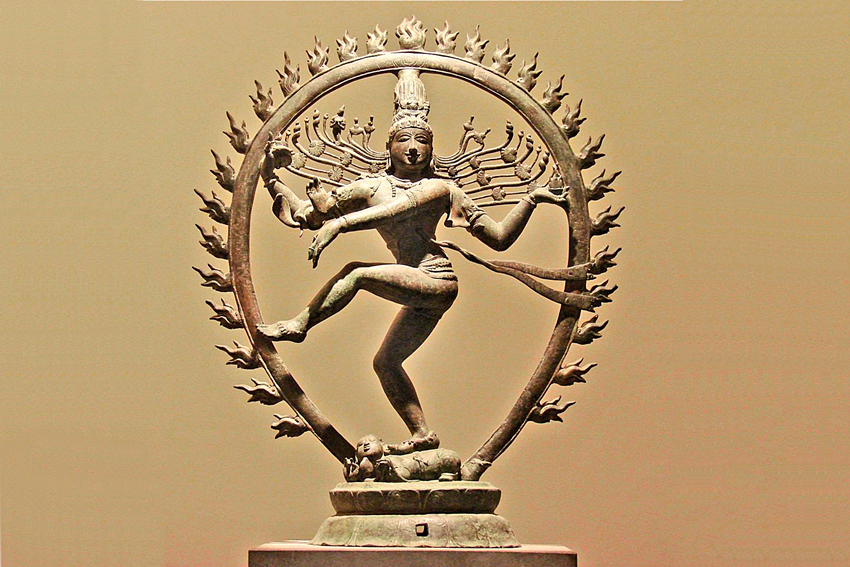Nataraj Symbolism of the Shiva dance

Nataraja or Nataraj, the dancing form of Lord Shiva, is a symbolic synthesis of the most important aspects of Hinduism and the summary of the central principles of this Vedic religion. The term "Nataraj" means "King of the dancers" (Sanskrit born = dance; raja = king). In the words of Ananda K. Coomaraswamy, Nataraj is "the clearest image of God's activity that any art or religion can boast of ... A more fluid and energetic representation of a moving figure than Shiva's dancing figure is not found almost nowhere, "(Shiva's dance)
The origin of the Nataraj form
An extraordinary iconographic representation of India's rich and diverse cultural heritage, it was developed in southern India by 880th and 1279th century artists during the Chola period (XNUMX-XNUMX AD) in a series of splendid bronze sculptures. In the XII century AD it reached canonical stature and soon Chola Nataraja became the supreme affirmation of Hindu art.
The vital form and symbolism
In a wonderfully unified and dynamic composition that expresses the rhythm and harmony of life, Nataraj is shown with four hands representing the cardinal directions. He is dancing, with his left foot elegantly raised and his right foot on a prostrate figure: "Apasmara Purusha", the personification of the illusion and ignorance on which Shiva triumphs. The upper left hand holds a flame, the lower left hand points towards the dwarf, who is shown holding a cobra in his hand. The upper right hand holds an hourglass drum or "dumroo" which represents the male-female vital principle, at the bottom shows the gesture of the statement: "Be fearless".
The snakes that represent egotism are seen unrolling from his arms, legs and hair, which is braided and jeweled. Her tousled locks swirl as she dances within an arc of flames that represents the infinite cycle of birth and death. On his head is a skull, which symbolizes his conquest over death. Goddess Ganga, the epitome of the sacred Ganges river, also sits on her hairstyle. His third eye is symbolic of his omniscience, intuition and enlightenment. The whole idol rests on a lotus pedestal, the symbol of the creative forces of the universe.
The meaning of Shiva dance
This cosmic dance of Shiva is called "Anandatandava", which means Dance of Bliss, and symbolizes the cosmic cycles of creation and destruction, as well as the daily rhythm of birth and death. Dance is a pictorial allegory of the five main manifestations of eternal energy: creation, destruction, conservation, salvation and illusion. According to Coomaraswamy, Shiva's dance also represents his five activities: "Shrishti" (creation, evolution); 'Sthiti' (conservation, support); 'Samhara' (destruction, evolution); 'Tirobhava' (illusion); and 'Anugraha' (liberation, emancipation, grace).
The general character of the image is paradoxical, combining Shiva's inner tranquility and external activity.
A scientific metaphor
Fritzof Capra in his article "The Dance of Shiva: The Hindu View of Matter in the Light of Modern Physics", and later in The Tao of Physics, beautifully connects Nataraj's dance with modern physics. He says that “every subatomic particle not only performs an energy dance but is also an energy dance; a pulsating process of creation and destruction ... without end ... For modern physicists, Shiva's dance is the dance of subatomic matter. As in Hindu mythology, it is a continuous dance of creation and destruction that involves the whole cosmos; the basis of all existence and all natural phenomena ".
The Nataraj statue at CERN, Geneva
In 2004, a 2 m statue of the dancing Shiva was presented at CERN, the European Particle Physics Research Center in Geneva. A special plaque next to the Shiva statue explains the meaning of Shiva's cosmic dance metaphor with quotes from Capra: “Hundreds of years ago, Indian artists created visual images of Shiva dancing in a beautiful series of bronzes. In our times, physicists have used the most advanced technology to portray the patterns of cosmic dance. The metaphor of cosmic dance thus unifies ancient mythology, religious art and modern physics. "
To summarize, here is an excerpt from a beautiful poem by Ruth Peel:
"The source of all the movement,
the dance of Shiva,
gives rhythm to the universe.
Dance in evil places,
in sacred,
create and preserve,
destroys and frees.
We are part of this dance
This eternal rhythm,
And woe to us if, blinded by
illusions,
we break away
from the dancing cosmos,
this universal harmony ... "